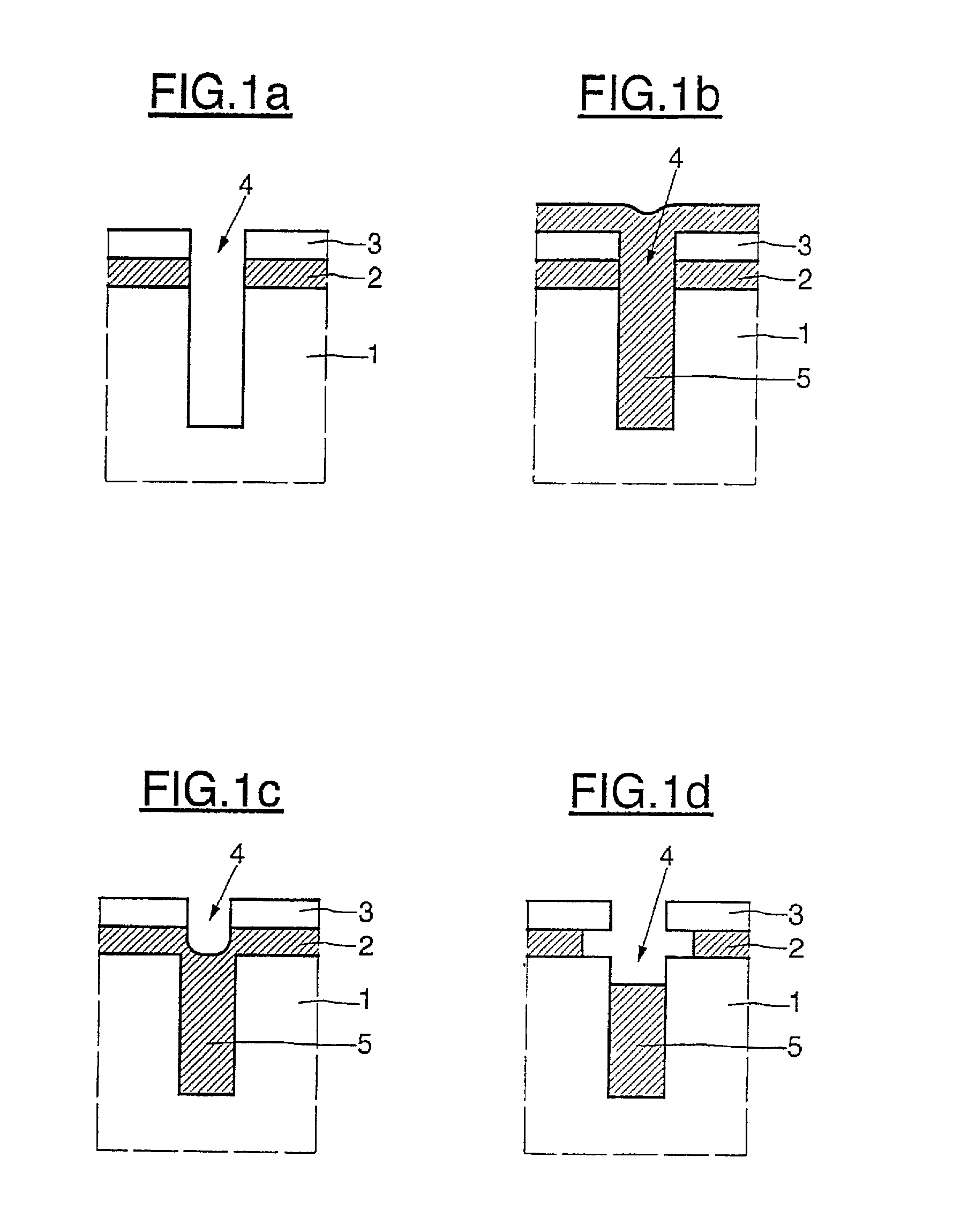Process for fabricating a single-crystal substrate and integrated circuit comprising such a substrate
a technology of single crystal substrate and integrated circuit, which is applied in the direction of solid-state devices, basic electric elements, electric apparatus, etc., can solve the problems of destroying the crystal continuity of the surface oaf portion of the initial single crystal semiconductor substrate, the surface of the portion of the substrate, and the fabrication of semiconductor components, so as to ensure the planarity and surface homogeneity
- Summary
- Abstract
- Description
- Claims
- Application Information
AI Technical Summary
Benefits of technology
Problems solved by technology
Method used
Image
Examples
first embodiment
[0051] an isolating trench is formed for the purpose, for example, of separating contiguous buried layers of opposite conductivity.
[0052]Thus, according to this embodiment of the process of the invention, the trench 4 is filled with a dielectric material. As dielectric material, it is preferred to choose silicon oxide.
[0053]The filling of the trench with silicon oxide 5 maybe carried out in various conventional ways.
[0054]It is conceivable to deposit silicon oxide as a conformal coating, as illustrated in FIG. 1b. The oxide is therefore also deposited over the entire surface of the wafer.
[0055]It is preferable, however, to use the deposition of silicon oxide by thermal oxidation, as illustrated in FIG. 1c. Firstly, this involves a method more suited to the presence of possibly narrow trenches. Secondly, a denser oxide is obtained than with the conformal coating.
[0056]Moreover, if the silicon oxide grows only on the silicon, only the trench 4, slightly widened by oxidation of the sil...
second embodiment
[0066] it is possible to produce a silicon substrate which has its surface made uniform according to the process of the invention and which includes a buried capacitor formed in a trench.
[0067]To produce such a substrate, a trench 4 is firstly formed as previously in the substrate 1, as illustrated in FIG. 1a. Next, a controlled thermal oxidation is carried out so as to form a silicon oxide layer 8 having a thickness of between 40 and 1000 Å, preferably between 50 and 300 Å, on the walls of the trench 4, obtaining the device illustrated in FIG. 2a.
[0068]Next, highly doped polycrystalline silicon 9 is deposited on the wafer so as to fill the trench 4. The doping of the silicon is carried out in situ.
[0069]A device like that illustrated in FIG. 2b is obtained.
[0070]Next, according to the process of the invention, the previously deposited polycrystalline silicon 9 is etched, so as at least to remove it from the surface of the wafer. Moreover, this etching is carried out until the poly...
third embodiment
[0080] it is also possible to form a buried diode in a silicon substrate, the surface of which is planarized as in the process of the invention, for the purpose of homogeneous epitaxy allowing electronic components to be produced.
[0081]According to this embodinent, highly doped polycrystalline silicon 10 is deposited in a trench formed as previously.
[0082]According to the embodiment illustrated in FIG. 3a, an n-doped substrate 1 and p+-doped polycrystalline silicon 10 have been envisioned. It is important to note however, that opposite conductivities also fall within the true scope and spirit of the invention.
[0083]Next, the polycrystalline silicon layer 10 formed on the surface is removed using standard methods. The removal of the polycrystalline silicon 10 is continued until a fill level below the surface of the substrate 1 is obtained.
[0084]This step is followed, according to the process of the invention, by a controlled deoxidation. This deoxidation is more fully described above...
PUM
| Property | Measurement | Unit |
|---|---|---|
| thickness | aaaaa | aaaaa |
| thickness | aaaaa | aaaaa |
| depth | aaaaa | aaaaa |
Abstract
Description
Claims
Application Information
 Login to View More
Login to View More - R&D
- Intellectual Property
- Life Sciences
- Materials
- Tech Scout
- Unparalleled Data Quality
- Higher Quality Content
- 60% Fewer Hallucinations
Browse by: Latest US Patents, China's latest patents, Technical Efficacy Thesaurus, Application Domain, Technology Topic, Popular Technical Reports.
© 2025 PatSnap. All rights reserved.Legal|Privacy policy|Modern Slavery Act Transparency Statement|Sitemap|About US| Contact US: help@patsnap.com



